The latest rankings of trade freedom around the world, developed by The Heritage Foundation for the forthcoming 2018 Index of Economic Freedom,[REF] demonstrate that citizens of countries that embrace free trade are better off than those in countries that do not. The data show a strong link between trade freedom and a variety of positive indicators, including economic prosperity, low poverty rates, and clean environments.
Worldwide, the average trade freedom score, which is based on a country’s tariff and non-tariff trade barriers, is unchanged from 2017, as seen in Chart 1.
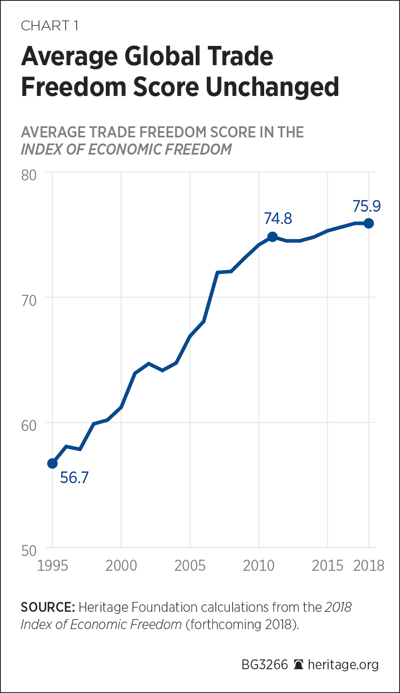
Why Trade Freedom Matters
A comparison of economic performance and trade scores in the 2018 Index of Economic Freedom demonstrates the importance of trade freedom to prosperity and well-being. Countries with the most trade freedom have higher per capita incomes, more secure food supplies, and cleaner environments.
In fact, as seen in Chart 2, the top third of nations by trade freedom earn over $27,000 gross national income per capita on average, compared with the middle third’s and lowest third’s much lower amounts of $7,400, and $3,100, respectively. Moreover, nations with more trade freedom have greater political stability and are less likely to experience politically motivated violence, including terrorism.
Greater freedom to trade makes for a freer, safer, cleaner, and healthier world. The benefits of trade accrue to citizens on both sides of an international transaction because trade is not a zero-sum activity. Countries that impose significant tariffs and non-tariff barriers hurt themselves and detract from the prosperity and happiness of their citizens.
Boosting Trade, Economic Freedom, and Prosperity
Since World War II, government barriers to global commerce have been reduced significantly. Today, the average worldwide tariff rate is less than 3 percent. The average world tariff rate has fallen by one-third since the turn of the century alone.[REF]
Countries with low tariffs and few non-tariff barriers benefit from stronger economic growth. But free trade policies do not just promote economic growth, they encourage freedom across the board—including protection of property rights and the freedom of average people to buy what they think is best for their families, regardless of attempts by special interest groups to restrict that freedom.
Not all countries have embraced free trade. Double-digit tariff rates are applied in 32 countries, and even countries with low average tariff rates often have high tariff rates for some items. In the U.S., for example, the average tariff rate is just 1.6 percent, but pickup trucks face a prohibitive 25 percent tariff, many types of clothing are subject to double-digit tariffs, and food—a basic necessity—can be subject to tariffs of as much as 35 percent (some canned tuna fish), or 132 percent (certain peanut products).[REF]
Identifying and Neutralizing Threats to Trade
The volume of U.S. and world trade in goods and services plummeted during the global recession, declining by roughly 20 percent between 2008 and 2009. From 2009 to 2014, U.S. and world trade volume increased by around 50 percent, followed by a 10 percent drop in world trade volume in 2015, along with a 4 percent decline in U.S. trade volume.[REF] The World Trade Organization (WTO) reported an increase in global merchandise trade of just 1.6 percent in 2016, but projects a strong rebound to 3.6 percent growth for 2017.[REF] U.S. trade in goods and services dropped 6.1 percent from its 2014 peak to 2016.[REF]
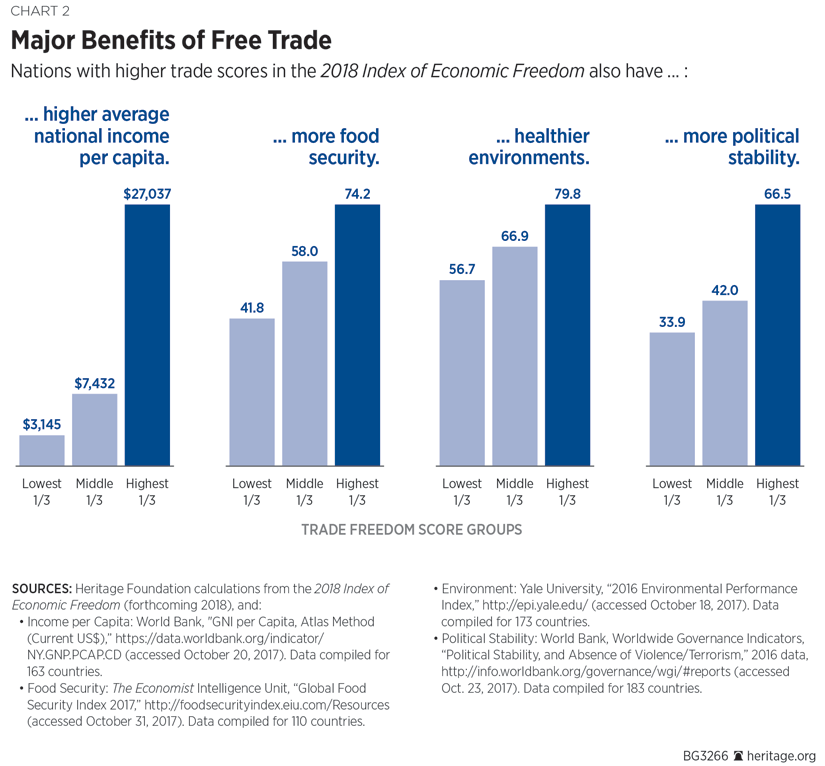
According to the WTO’s July Trade Monitoring Report (October 2016 to May 2017),
74 new trade-restrictive measures were initiated by members during the review period, including new or increased tariffs, customs regulations and quantitative restrictions, amounting to almost 11 new measures per month. This constitutes a significant decrease over the previous review period (mid-October 2015 to mid-October 2016), where an average of 15 measures per month were recorded, and marks the lowest monthly average over the past decade.[REF]
Although much progress has been made in identifying and reducing tariffs and many non-tariff barriers, Global Trade Alert identifies government subsidies as a growing impediment to trade: “As far as crisis-era trade distortions are concerned, the action is in state financial support, not import restrictions. G20 policymakers, their advisers, and analysts would do well to recognize where the real threats to global trade are really coming from and their worrying scale.”[REF]
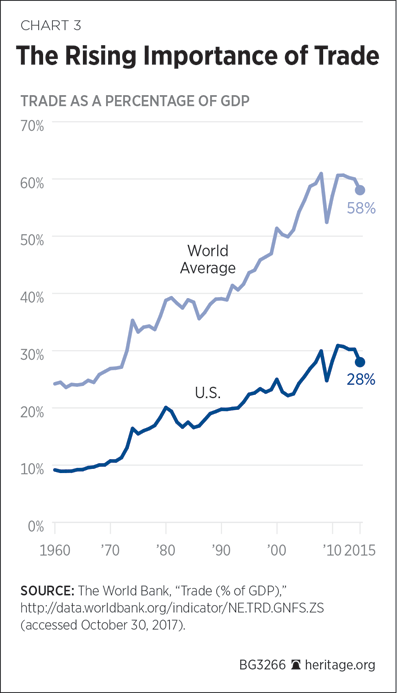
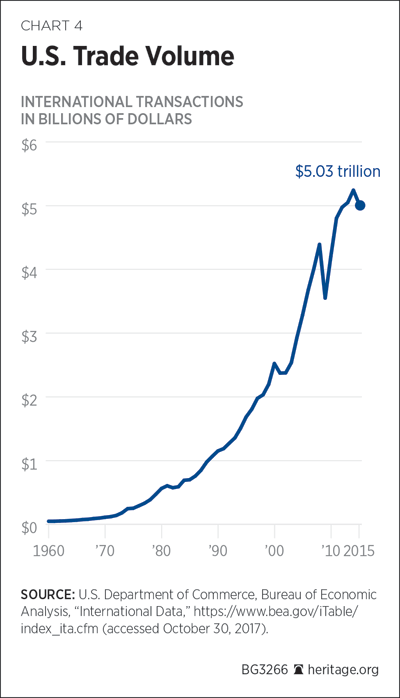
Support for International Trade in the U.S.
Free trade is undoubtedly popular among American economists. The University of Chicago’s Initiative of Global Markets (IGM) asked a panel of economic experts to respond to the following proposition: “Adding new or higher import duties on products such as air conditioners, cars, and cookies—to encourage producers to make them in the US—would be a good idea.” One hundred percent of respondents either “disagreed” or “strongly disagreed.”[REF]
A 2012 IGM survey found that more than four out of five economists surveyed agreed that “[o]n average, citizens of the U.S. have been better off with the North American Free Trade Agreement (NAFTA) than they would have been if the trade rules for the U.S., Canada and Mexico prior to NAFTA had remained in place.”[REF]
But support for trade is not limited to economists. Despite ongoing anti-trade rhetoric, repeated public opinion polls demonstrate that most Americans continue to support international trade. For example:
- According to a poll conducted by The Heritage Foundation, 70 percent of Americans think trade has been a good thing for the U.S., while just 7 percent think it has been bad for the country.[REF]
- A Morning Consult poll from September 2017 found that 52 percent of Americans support an expansion of free trade across borders, versus just 25 percent in opposition.[REF]
- The Chicago Council on Global Affairs concluded in August 2017: “More Americans than ever are convinced that international trade is generally advantageous to the United States,” based on poll results showing that 72 percent of Americans believe trade is good for the U.S. economy.[REF]
- Gallup reported in February 2017 that a “record-high 72 percent of Americans see foreign trade as an opportunity for economic growth. This is up sharply from 58 percent last year, after much debate about trade during the presidential election cycle.”[REF]
- A Wall Street Journal/NBC News poll from February 2017 showed “the highest portion of Americans who said free trade helped more than hurt since the Journal/NBC News pollsters started asking that question in 1999.”[REF]
- A survey of people who voted for President Trump, from April 2017, found that “stopping the job-killing impacts of foreign trade deals” ranked dead last among choices for what the President’s top priorities should be, far behind strengthening national security, creating jobs, stopping illegal immigration, and repealing Obamacare.[REF]
What U.S. and World Leaders Can Learn from the Index of Economic Freedom
Economic theory suggests that countries with reduced barriers to international trade and investment will prosper compared to countries that restrict trade. The 2018 Index of Economic Freedom provides evidence that supports this idea.
People who live in countries with low trade barriers are better off than those who live in countries with high trade barriers. Reducing those barriers remains a proven recipe for prosperity. Governments interested in higher economic growth, less hunger, better environmental quality, and less risk of political unrest should promote freedom, not pander to vocal minorities who want to restrict it.
—Bryan Riley is Jay Van Andel Senior Policy Analyst in Trade Policy, in the Thomas A. Roe Institute for Economic Policy Studies, of the Institute for Economic Freedom, and Patrick Tyrell is Research Coordinator, in the Center for International Trade and Economics, of the Kathryn and Shelby Cullom Davis Institute for National Security and Foreign Policy, at The Heritage Foundation.
Appendix A
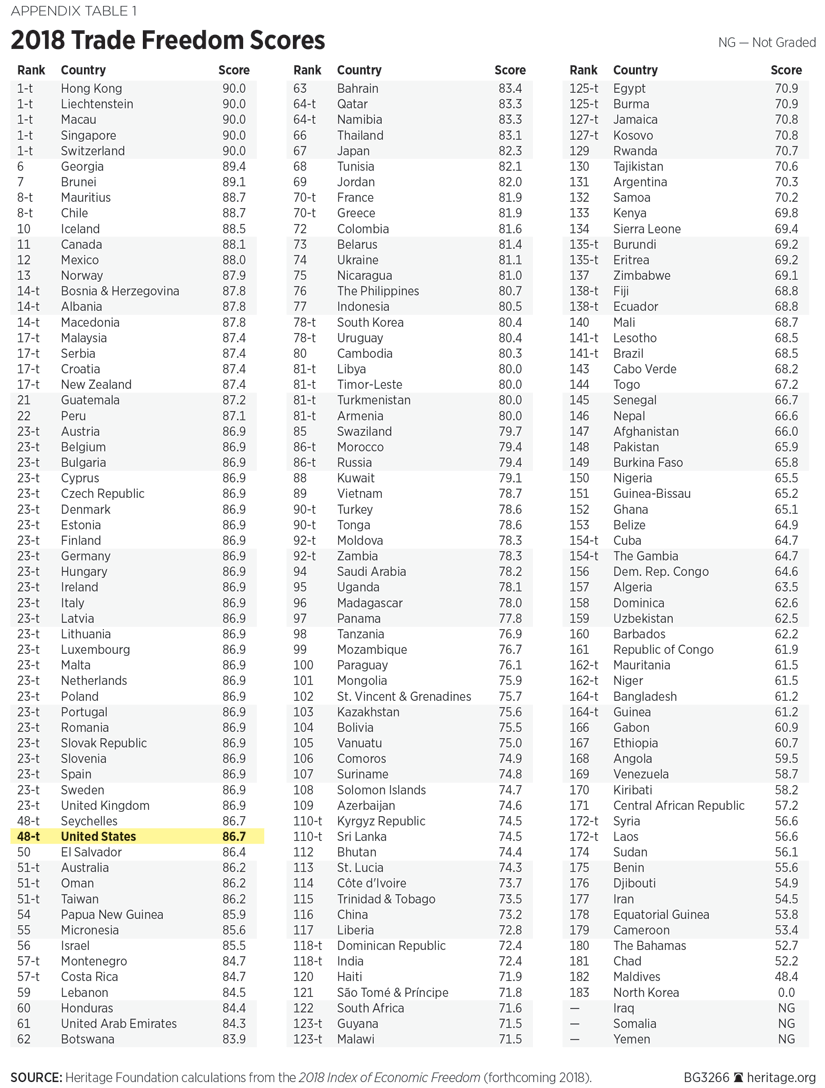
Appendix B: Methodology
The trade freedom scores for 2018 are based on data for the period covering the second half of 2016 through the first half of 2017. To the extent possible, the information is current as of June 30, 2017. Any changes in law effective after that date have no positive or negative impact on the 2018 tradefreedom scores.
Unless otherwise noted, the authors use the following sources to determine scores for trade policy, in order of priority:
- The World Bank,World Development Indicators 2017.
- The World Trade Organization,Trade Policy Review, 1995–2017.
- Office of the U.S. Trade Representative,2017 National Trade Estimate Report on Foreign Trade Barriers.
- The World Bank,Doing Business 2016andDoing Business 2017.
- U.S. Department of Commerce and U.S. Department of State,Country Commercial Guide, 2012–2017.
- Economist Intelligence Unit,Country Commerce, 2017.
- World Economic Forum,The Global Enabling Trade Report 2016.
- Official government publications of each country.


